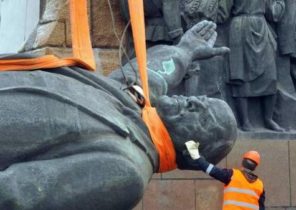Recently, the Russian government informed about the oil spill, which probably is the largest in the history of the Arctic. So first, what did the President of Russia Vladimir Putin, it had a videoconference with the officials responsible for the incident and criticized them. Responsible for the accident, the company notified the government about the fuel spill, only two days later, when it became clear that the damage is too huge to be able to cope with it. 29 may 2020 20 thousand tons of diesel fuel spilled into the river Barn in Siberia, and five days after the accident (and three days after Putin learned about it) in the region was declared an emergency of Federal scale.
Putin rarely considers it necessary to introduce a state of emergency in the country, but the destruction of the tank in Norilsk owned by Norilsk Nickel, very dangerous. The oil spilled in a radius of 12 kilometers from the location of the tank, contaminating an area of 530 square kilometers, of which the river has acquired a dark red color.
The destruction of the tank was caused by a drawdown of its pillars, which have been in use for 30 years and, according to the company’s information, are verified every two years. The results of the checks they didn’t need any maintenance and could last for another two years.
This incident recalls the accident with the explosion of the nuclear reactor in Chernobyl, when bureaucratic obstacles and misinformation has led to the fact that all the necessary measures were not taken and the situation got out of control. It seems that Russia has not learned that lesson, but even if this time we believe the company’s information and official reports, the collapse of the reservoir will teach this country another — climate change is a reality.
Reports say that the spill of fuel was caused by the destruction of the permafrost layer. The plant was built entirely on the layer of the permafrost in the Arctic. This region is constantly changing due to climate change, including a steady increase in temperature, but Putin and his entourage do not believe that these changes are real, and not wanted to take precautions.
This is not the first accident and not the last
Whatever the reason, this time, and regardless of whether the company recognized its liability, as in 2016, when he said that the painting of the river Daldykan in red due to contact with contaminated water, Russia will be a disaster. According to experts, because of the scale of the oil spill got into the river, the cleanup could take an average of 15 years, and the most optimistic estimates, up to 10 years. Perhaps this figure will increase as local authorities announced that the cleaning works will start only a few weeks due to the absence in Siberia the necessary funds to combat the scourge. In addition, the river is not navigable, and around it there are no roads.
Every day of delay cleaning so that the bottom of the river more and more absorbs harmful substances. Already in the ground left 6 thousand tons of oil. In other words, if to clean the surface of the river will take 10 years, in order to become suitable for living organisms, need a decade.
This is not the first such incident of oil spill, whether in Russia or in the world as a whole. The situation in Siberia has only amplified calls of the international community, facing the Houthis with a request to allow access of the UN delegation, to a Safer tanker. This tanker, owned by the government of Yemen, represents a huge fuel tank, intended for crude oil from the North of Sana’a, the Houthi coup, however, prevented the export to accumulated fuel and made it impossible for any measures in the framework of maintenance of the tanker.
Leaked to the network photos taken by Yemeni activists demonstrate the scale of the disaster around the tank. One million and 278 thousand barrels of crude oil on the ship is a bomb ready to explode at any moment. The tragedy is that the consequences will be faced not only Yemenis, and all the countries overlooking the Red sea. 20 thousand tons of oil destroyed the coast of Siberia, which will make the region of 150 thousand tons on Board Safer?
If the hull of the tanker, which has not been repaired for many years, has eroded, it will be sunk off the coast of the red sea. When a similar accident occurred in Brazil in 2019, 130 local beaches were covered with oil. The President of Brazil Jaira Bolsonaro did not care about the reasons why the country is still suffering from the consequences of the accident.
The scenario of an oil spill persists, and the world is still surprised
These accidents don’t seem to be serious on the background of a truly catastrophic incidents in the seas and oceans of the world over the past decade. In 1983, a strong storm sank the tanker Amoco Cadiz off the coast of France. The fuel is completely leaked in the channel, including branch that leads to the 76 various beaches, and the radius of the spill increased to 29 kilometers. In the same year, lit up the Spanish tanker Castillo de Bellver, which was heading to the Persian Gulf. The fire ship was divided into two parts: 110 thousand tons of fuel sank, and the remaining 140 thousand tons of oil appeared on the surface.
In the same year, during the Iran-Iraq war, an oil tanker collided with a platform in the Nowruz field in the Persian Gulf. As a result of collision there was a spill of nearly 80 million gallons of oil, which lasted seven months, and 11 people died.
Five years later, the tanker “the Odyssey” once again reminded the world about the oil spill. Liberian tanker was loaded with 43 million gallons of oil, and one spark turned it into a huge flame. The explosion claimed the lives of 27 crew members, and the entire cargo spilled into the Atlantic ocean. The accident occurred in 1988, and three years later had another one!
Massive tanker MT Haven, carrying 45 million gallons of oil, exploded near the coast of Italy, and then sank, and its crew died. Oil has been found in the Mediterranean sea, and 12 years, the region suffered from the effects of this spill. May 28, 1991, the oil tanker ABT Summer exploded off the coast of Angola. In the result of 51 million gallons of oil spilled on the area of 207 square kilometers, and the tanker continued to burn for three days, until they finally sank with five crew members.
History experts remarked that the year 1991 was a time of catastrophic oil spill: then there was another similar incident, but had intentional. When Iraqi troops withdrew from Kuwait during the second Gulf war, they opened the pipelines and valves of oil wells, and then burned the oil to prevent the landing of American troops in the region. The first ignition occurred in January 1991, and the last well was extinguished in April of the same year. Thus, the oil wells burned for 120 days, and this has led to the leak of 240 million gallons of oil!
“Deepwater horizon” is more than just a movie
Despite the magnitude of past accidents, they have not attracted much attention at the global level, unlike the tragedy at Deepwater horizon, so that even Hollywood wanted to film it. The incident occurred in 2010, as the result of a gas leak, which led to the explosion on the oil rig “Deepwater horizon”, owned by oil giant British Petroleum. The explosion instantly killed 11 people and the oil spill lasted more than three months without a break, on average, every day spill of 53,000 barrels of oil. The accident also killed 82 thousands of birds, 26 of thousands of marine mammals, 6 thousands of sea turtles and thousands of fish.
Decades an exorbitant price for what happened do not pay people, and other inhabitants of our planet, so the oil spill tops the list of disasters that threaten all aquatic life. If the fish did not die from poisoning by oil at the time of the spill, it will still die in the future, as it feeds on coral reefs, in which are deposited harmful substances. If the birds do not die in the fire, they will die of starvation because the oil forms a thick barrier that prevents them to see your sea food, and when the bird is in danger of flying up to the water surface, the oil sticks to the wings and can not fly back. She just dies.
Air and plants are polluted as a result of oil spills due to fires. In addition to the direct damage and indirect, for example, deterioration of the living conditions of fishermen after the cessation of fishing in contaminated areas. In addition, for several years stops the marine and terrestrial tourism. The damage starts with ordinary workers and ends with the reduction of the national income of the state.
Why countries just not pumping oil?
Because the damage caused by the oil spill, is so great, countries are continually seeking new ways to eliminate potential spills. One of the first methods of fixing leaks is bioremediation using microorganisms that are able to live and eat oil, thereby destroying a major oil spill and turning them into methane or carbon dioxide which are then released into the atmosphere.
The second method is what comes to mind every time we hear about oil spills, namely pumping. Giant pumps, skimmers, carried enormous vessels pull the oil and collect it in giant containers and then transporterowych them to the refineries, to again use. Although this method seems very simple, it is also the most expensive method of dealing with spills. In addition, often apply it simply impossible, because it is necessary that the oil was concentrated in one place, which is possible in the absence of wind and water currents. Since the wind and current is always there, countries rarely resort to this method. This usually happens if the spill is small.
Another method, which is used in the country is the use of chemicals that interact with oil and turn it into a solid product which sinks to the bottom. This method allows you to break the oil film, allowing the sun and air to reach the marine life. Otherwise, they face death.
There are also less common methods, for example, using the seed husks of rice, which absorbs the oil, facilitating its extrusion, and water purification. Another innovative method applied by some American companies, especially in times of crisis around the platform “Deepwater horizon” is the use of hair. The company agreed with tens of thousands of beauty salons throughout the United States to gather cut hair of clients instead of throwing them in the trash. The company then started to produce a network of human hair, which serve as a good sorbent for oil.
Ignoring the problem: how some countries handle oil spills
The last way to which can resort in the country is burning. They set fire to an oil slick to it have disappeared with time, especially if it is far away from residential areas and tourist beaches. Some countries have decided to set up barriers that do not allow oil and contaminated water to reach certain coastal areas, doing nothing with the contaminated water. Others decide to opt out of any measures, leaving the oil in the hands of the tides, so she went far away from the shore.
Surprising is the fact that regardless of the hardness and speed of the cleaning measures, countries have been unable to restore what was. The oil spill that occurred in 1989 because of the American companies Exxon Valdez, which killed 250 thousand sea birds, and 22 of the whale seemed to have been overcome. However, the study conducted by the National oceanic and atmospheric administration in 2007 showed that the beaches of Alaska contain approximately 26,000 gallons of oil, and this figure has been reduced by only 4% per year.
Thus the oil spill is a true disaster when it is not enough to apologize and promised to punish the guilty. Its consequences will threaten living organisms for many decades and may lead to the extinction of entire species and systems.







